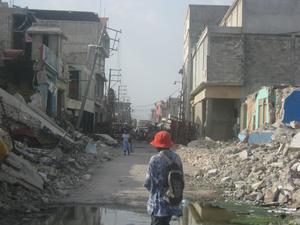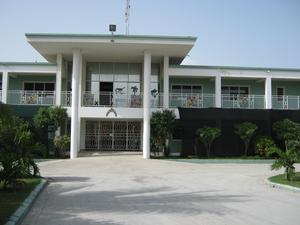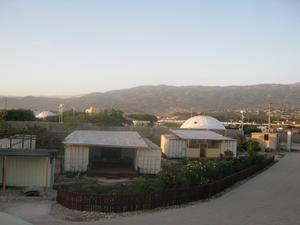
By DR. ANTHONY ALESSI
Scorching sun beats down on a group of Haitian men as they unload 5,000 bags of rice. Amazingly, each man carries up to four sacks weighing 55 pounds each. The laborers will receive $50 in American currency for their work, but you can’t put a price on the end results — helping to erase the hunger and malnutrition that surround them.
The rice was not donated. It was purchased by the Rev. Rick Frechette and delivered to St. Damian’s Hospital at a cost of $18 per sack.
Ironically, there are nearby warehouses filled with donated food and supplies, their distribution locked in bureaucracy. Some of those supplies are the same ones I saw during my visit in March, and the expiration dates have now passed. While former President Bill Clinton and his envoy talk to reporters about this injustice, little is being done to halt preventable fatalities. The lack of an effective dispersal infrastructure is not only maddening, it is deadly.
Six long months have passed since the earthquake in Port-au-Prince. Having just returned from my third trip working at St. Damian’s, the only free children’s hospital in Port-au-Prince, I am happy to report that although progress throughout Haiti has been painfully slow, many improvements are apparent.
The city of Port-au-Prince is essentially unchanged from my first post-earthquake visit in January. Large piles of rubble and twisted metal are apparent on most downtown streets. What has changed is the visible effort to get back to some level of normalcy. Although drastically diminished in numbers, vendors have returned to the streets. Artisans have begun to take metal bars that once reinforced concrete and shape them into useful household devices, such as bed frames and shelves.

Arrive early for aid
The Haitian medical staff of St. Damian’s has largely returned, but the number of children needing care has increased dramatically. Mothers and infants begin gathering at the gate at 4:30 a.m. for outpatient care. The emergency room is seeing record numbers of infants, many suffering from malnutrition and related diseases. A new EEG machine has been donated by an Italian charity and staff was sent from Verona, Italy, to train Haitian technologists.
A CT scanner donated by the McDonald’s Foundation of Germany will be arriving soon. It will be only the third working CT scanner in Port-au-Prince, and the images will be transmitted to Backus Hospital for expert interpretation by members of the Norwich Diagnostic Imaging Associates.
I primarily worked at Kay St. Germaine, a rehabilitation hospital for children with neurological disorders, adjacent to St. Damian’s. The first day started with a meeting of more than 50 parents whose children suffer from illnesses such as cerebral palsy, Down syndrome and epilepsy. My goal was to address why their children are different and encourage the parents to continue bringing them for therapy each week.
I explained that their children are no different from children in the rest of the world who have these same problems, but it was when I began taking questions that my challenge became apparent. Successive heart-wrenching stories all ended with the same question: “When will my child be better?”

School will reopen
St. Vincent’s School for deaf and blind children was run by a group of sisters in downtown Port-au-Prince. On Jan. 12, the school was reduced to a pile of stone. Some children perished in the school, but the majority of almost 200 students have been left without a school while the sisters regroup. Father Frechette has opted to connect shipping containers and build two classrooms, restrooms and a fenced-in play area to provide a temporary location for these needy children. It is scheduled to open this week.
The biggest development has been the opening of The St. Luke Family Health Center. Its temporary structure consists of well-used shipping containers connected by corrugated metal roofing and a concrete floor. The first patients had primarily orthopedic earthquake-related problems requiring corrective surgery. Soon to be added is a trauma center with four operating rooms that is being constructed in Europe.
At this point in the Haitian recovery effort, it is apparent that charities that have immediately directed funds to victims have had the greatest impact. In general, these have been smaller groups that have had longstanding relationships in Haiti, such as the Passionist Order of Priests and Brothers (www.compassionweavers.com) and, locally, the Haitian Health Foundation (www.haitianhealthfoundation.org).
It is my hope that over the course of the next six months, more progress will be made toward getting back to a state of normalcy. Any successes in Haiti will require continued financial support as well as a physical presence.
—————————————————————————————————–
COMMENT:HAITIAN-TRUTH.ORG
This one focuses on the real situation that seems to be overlooked by everyone.
Preval has effectively stopped everything, one way or another, Preval’s ministries are the first hurdle in the slow-down – or stop – effort…then his port facility slows things down, while his customs people follow up and stall things…
Each step sees people die from lack of food, medicine or shelter… and the situation continues to deteriorate under the nose of Bill Clinton and the International Community.
Unless something is done, Preval will steal or stall the scheduled November elections.
When will the world wake up?!